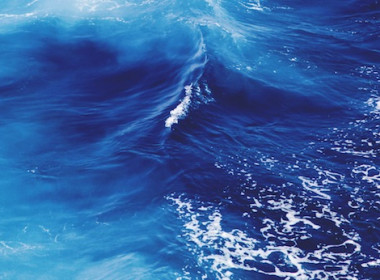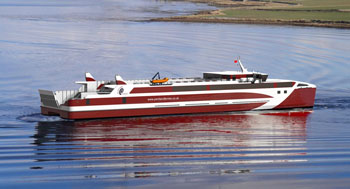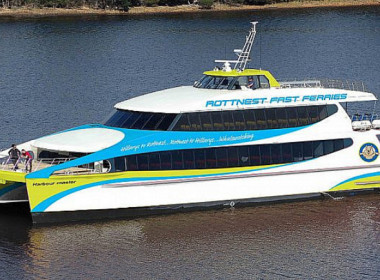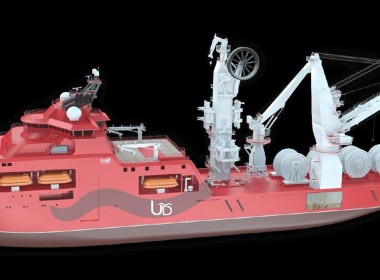EDITORIAL | Cook Strait checkmate: new solutions for safer New Zealand ferries

Nearly 900 people were on KiwiRail Interislander’s 29-year-old ferry Kaitaki when it lost power in a storm in January 2023 whilst entering Wellington Harbour en route from Picton on the South Island.
Thankfully nobody died, and in the end the passengers remained safely on the ship rather than evacuating into lifeboats, but if you needed a red flag for a future catastrophe, this was it – and a bright red one at that.
Maritime New Zealand is filing a charge under the Health and Safety at Work Act against KiwiRail over the incident, but this case is unlikely to address the two key safety issues that New Zealand faces: an ageing ferry fleet, and a lack of emergency towing capability to assist vessels in distress.
In short, the first problem is that the Cook Strait ferries are increasingly aged, and this is especially true for the NZ government’s KiwiRail ships that have an average age of 27 years. Shortsightedly, the government has decided that replacing them is too expensive, whereas their free enterprise competitor, StraitNZ, has ships that average 22 years old.
The problem lies not only in the cost of the replacement ferries themselves, but also because someone (likely a consultant) decided that bigger ones were needed, so NZ$1 billion (US$600 million) was required to upgrade the harbour infrastructure alone.
“It should not take a second broken-down ferry drifting in the Cook Strait to compel change”
One obvious solution would be to build ships of identical dimensions to the existing units and then there would be no need to spend a billion Kiwi dollars on the port facilities. If extra capacity was needed, the operators could simply build more of the same units rather than bigger ships. We feel that that there are even better options that could provide better performance, higher levels of safety, and a smaller environmental footprint than simply replicating the conventional solutions from three decades ago.
But then, as with so many government-owned ship operations globally, no realistic provisions for depreciation and replacement appear to have been made. Our Offshore Accounts column has covered the ongoing “Ferry Fiasco” in Scotland, where the Scottish state-owned ferry operator at least ordered two new ferries but then made a disastrous choice of shipyard.
In New Zealand, work on replacement ferries has not even started, Instead, a newbuild order for two ships at Hyundai Mipo Dockyard in Korea was placed, then axed, no doubt at considerable cost to New Zealand taxpayers, after the government rejected state-owned KiwiRail’s request for extra funding.
This is insane. The Interislander ferry service moves on average NZ$14 billion (US$8.4 billion) in freight and over 800,000 passengers between the islands each year over a distance of a mere 47 nautical miles, which is covered at the rather pedestrian average speed of 15 knots. That vital but tiny gap must be covered, but how?
Unfortunately, New Zealand is just beginning to recover after six years of incredibly wasteful utopian socialist idealistic government under its juvenile past Prime Minister Jacinda Ardern. It simply has no money and limited borrowing capacity while its new government tries to repair the damage wrought by its incompetent and profligate Labour Party predecessor.
When will the existing ferries be upgraded? Are they expected to work to forty or fifty years? At what point are the engines considered obsolete? When does the rising cost of maintenance and falling reliability force the government’s hand? It should not take a second broken-down ferry drifting in the Cook Strait to compel change.
“You either go out and be blamed, or stay in port and watch the tragedy unfold…and be blamed”
There are apparently multiple rubber components in the power train of Kaitaki, and we understand that the replacements should not be more than six months old when installed. However, these engines are now effectively verging on the obsolescent. The longer the replacement ferries take to be ordered and built, the greater the risk, and the more the current situation starts to look “third world”. That verges on the negligent, if not suicidal.
The second problem is that Maritime NZ has allowed the harbour tugs in Wellington and Picton to be downrated so that they are not suitable for ocean-going towage and salvage operations. The harbour tugs at Picton each generate less than 30 tonnes bollard pull, and the pair in Wellington could each go no higher than 60 tonnes bollard pull. We understand that all the harbour tugs have restricted manning and cannot legally operate outside port limits due to these crewing issues. If correct, that is very risky.
So, in the event that a ferry was to lose power and start drifting onto rocks, there would be no tug with sufficient power to perform emergency towing. And if it was outside the harbour, someone would have to make a decision to override the manning limits on the existing tugs, which, with the litigious HSE environment in New Zealand, would inevitably invite a law suit. You either go out and be blamed, or stay in port and watch the tragedy unfold…and be blamed.
New Zealand is almost unique amongst developed countries in not having a proper emergency towing vessel (ETV) service, even though it has large ferries with up to 1,600 people on board traversing sometimes very rough seas in Cook Strait. Historically, there have been larger anchor handlers working out of New Plymouth supporting OMV’s oil and gas operations, but these are too far away to provide immediate intervention of the sort needed when a ferry gets into difficulties.
“It is not as if the recent history of New Zealand does not provide sufficient warnings of the dangers of the current penny-pinching and operationally inept situation.”
The need for national ETVs is well-established elsewhere in the world.
Les Abeilles provides this service in France with 200-tonne bollard pull vessels bought from Siem Offshore (covered previously in a vessel review and in Hieronymus Bosch’s column) and operates ETV bases in both Brest and Toulon. The Icelandic Coastguard has a 200-tonne bollard pull ex-UOS anchor handler in this role.
The UK has just awarded the 140-tonne AHTS Levoli Grey a five-year emergency towage charter from Marnavi. Lastly, South Africa recently re-contracted Amsol’s 220-tonne bollard pull anchor handler, the 2013-built Umkhuseli, for three more years. This ship was originally built for Toisa in Wuchang in China and was then bought by Eastern Navigation in Singapore before being sold to its current South African owners.
The situation in Wellington is insane! The NZ government should mandate an ETV for the Cook Strait and pay for its charter, just as Australia does with the Great Barrier Reef ETV with Smit Lamnalco. The recent newbuild vessel to protect the Queensland coast shows that new AHTSs are still available at rational prices despite the recovering OSV market.
The Spanish sea rescue agency Salvamento Maritimo has also just taken delivery of Heroinas de Salvora, a newbuild 200-tonne salvage vessel built by Zamakona Yards and designed by Seaplace.. This vessel highlights the diverse operational requirements for an ETV – with firefighting capability to Fifi-2 standard, oil spill response equipment and oil recovery class notation, cranes, and towing and anchor handling winches, diesel-electric propulsion, and even a drone hangar for response management.
Therefore, if it cannot provide an ETV, despite this being the international standard and clear best practice, the NZ government should at the very least mandate a minimum 80 tonnes bollard pull oceangoing tug as an emergency towing vessel in each of Wellington and Picton harbours, and provide a subsidy to the ports for their service and sufficient crewing for extended emergency scenarios.
This should also be backed by at least annual Maritime NZ emergency response training, simulating a drifting Cook Straits ferry requiring towage out of port limits. Other response scenarios might include the mass evacuation of all the passengers after a ferry grounding in rough weather, or a serious ferry fire (topical, given the increased use of battery electric vehicles and the recent fire casualty Fremantle Highway), or the grounding of a ferry with an oil spill in Wellington harbour and disruption to commercial traffic.
It is not as if the recent history of New Zealand does not provide sufficient warnings of the dangers of the current penny-pinching and operationally inept situation. In October 2011, the Costamare-owned container vessel Rena grounded off Tauranga and broke in half, causing a major oil spill.
Exactly the worst-case ferry scenario occurred in New Zealand’s most deadly modern maritime disaster in 1968: the loss of the Lyttelton–Wellington ferry Wahine and 51 of its passengers and crew in a situation not very dissimilar to the loss of power on Kaitaki.
“Hoping everything will be all right is not an emergency towing strategy”
Thinking more laterally and constructively, there are, in addition to the ETV imperative, other significantly less costly and more practical solutions to the Cook Strait ferry safety problems than those proposed by the existing operators. These include the following:
- Encourage the free enterprise operator Strait NZ/Bluebridge to commence replacing its now “middle-aged” ferries with new or even secondhand 120-metre, fast catamaran Ro-Pax ferries from Austal or any other local builder – they would be considerably cheaper to buy and operate than the conventional ferries apparently envisaged by both companies. They have also proved to be significantly safer. Even at a reduced speed of, say, 25 knots (for economic reasons), they could cover the route in two hours rather than three plus as at present.
- Close the government-owned KiwiRail Interislander operation immediately – it is hopelessly uneconomic and really only a “sheltered workshop” for the benefit of KiwiRail employees and their unions. As for carrying trains on ships, how utterly illogical can one get? Much the same applies to buses. And why have sleeping cabins for a three-hour voyage? That is costing Kiwi taxpayers very dearly.
- Invite the establishment of a new free-enterprise competitor to Strait NZ to also operate fast catamaran ferries.
- Ask local fast ferry builders to advise on the installation of rational, economical “link span” berthing facilities at a tiny fraction of the cost of the billion-dollar infrastructure envisaged by the government.
In the spirit of New Zealand’s ecological ethos, serious attention should also be given to electrically-powered ferries. The future is green, and the future should definitely include emergency towing capability and new ferries on this critical route.
The ferry solutions of the twentieth century are not fit for purpose in the 2020s. Hoping everything will be all right is not an emergency towing strategy. New Zealand needs to bite the bullet and invest before there is a serious incident.
The Waitaki engine failure incident was a timely warning, and it should be heeded.
Those who do not learn from history are doomed to repeat it. New Zealanders need to think again – very carefully.







